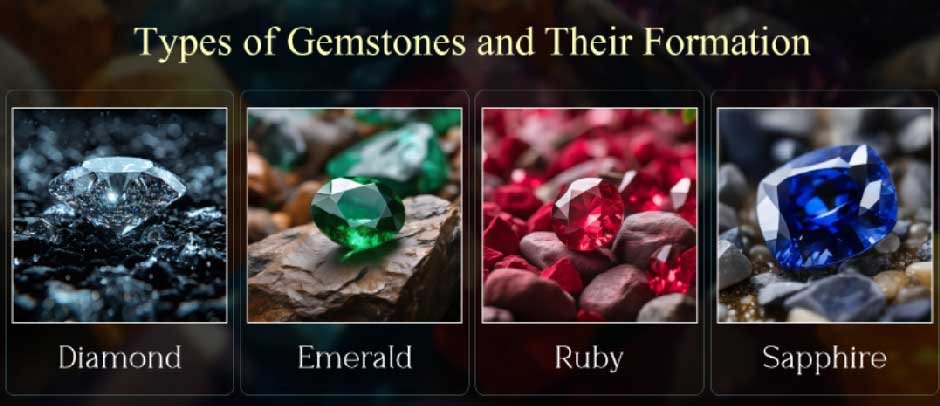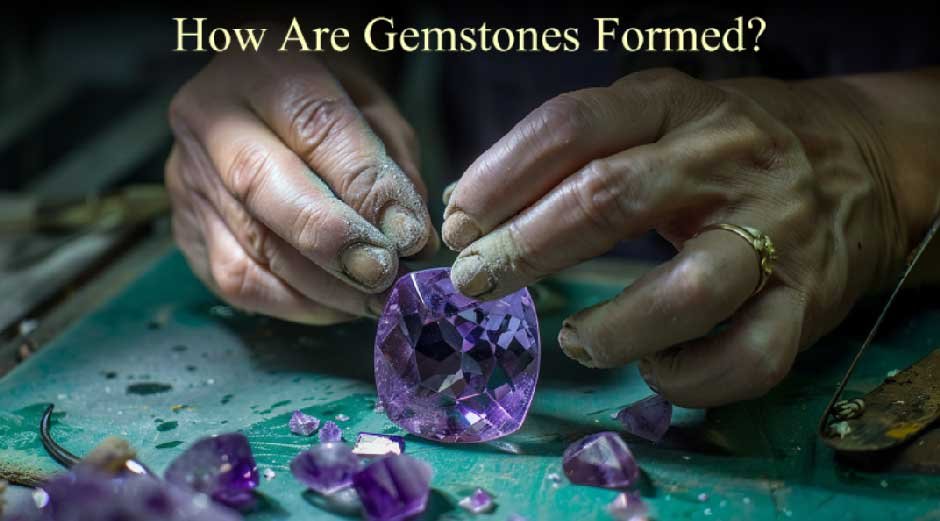Skip to the good bit
ToggleEver think about how a gemstone makes its way from the ground to sitting pretty in your jewelry box? Geology tells an interesting tale about ‘how are gemstones formed’, all happening right under our feet as pressure, temperature, and time work their magic.
Let’s explore what is gemstone made of, how they’re formed with raw minerals into sparkling treasures like – Gemstone Pendants, rings, earrings, and many more we wear.
What are Gemstones?
From deep down earth to brilliant rings and earrings, imagine a gemstone’s journey. Natural elements become precious gemstones via an intriguing process. The material originates from natural resources and must be aesthetic, hard, and rare to form the basis for creation. Afterward, artisans would cut down and shape the raw materials into forms suitable for jewelry and other accessories.
If you are wondering, ‘what is a gemstone made of’? To answer your question, gemstones are composed of minerals. Minerals are inorganic elements that exist naturally and have a certain chemical makeup and crystalline structure. Many gems are extremely hard or too brittle and collectors mainly set them in museums or purchase them.
Such stones exhibit exotic and rare qualities characterized by color, clarity, and other attributes. From diamonds to sapphires, every stone tells a tale of geological marvel and masterly efforts.
Geological Processes Behind Gemstone Formation
Geological activity and the creation of the earth’s crust cause gems to form and crystallize minerals.
- Igneous Formation
Igneous gemstones form in the lower part of the earth’s mantle, where high temperature and pressure are most suitable. The mantle, composed of molten rock called magma, is a layer inside the earth. Volcanic activities transport these gemstones to the surface through mineral-rich magma. High temperatures and pressure, followed by volcanic activity, produce igneous gemstones. These mesmerizing stones result from active processes within the earth’s crust and upper mantle.
- Metamorphic Formation
Geologists form metamorphic gemstones in the upper mantle due to high pressure and temperature caused by tectonic plate movements. These processes dissolve and liberate minerals, which then reconstitute into new minerals with different formulas. Sapphires, rubies, spinels, and garnets are among the metamorphic gems with vivid colors that result from these transformations.
- Sedimentary Formation
The deposition and interaction of water and minerals on the earth’s surface form sedimentary gemstones. This process creates layers of minerals in rock crevices, producing beautiful gems such as opal, malachite, and azurite. Water containing silica flows into rock crevices, where silica spheres align and layer, making opal formation unique. Gemstone collectors highly seek these stones for their model, shade, and surface texture. The mineral resources in sedimentation areas influence the uniqueness of the gemstones, offering many selections to lovers and collectors.
- Hydrothermal Formation
At very high temperatures, hot water forms hydrothermal gems by dissolving minerals such as silica, phosphates, and borates. When the temperature decreases, these minerals precipitate out, creating gems like amethyst and topaz. In geothermal provinces, these hot springs and geysers can contribute to the formation of gemstones because cooling water does participate. The formation of such stones and the fascinating peculiarities of hydrothermal gemstones drive their high demand.
Conditions Necessary for Gemstone Formation
How are gemstones formed? Certain conditions require the stone to be subjected to specific temperatures, pressures, and chemicals for a given period.
Let’s Check Out Factors Influencing the Gemstone Formation
- Temperature: Each gemstone forms uniquely at its precise temperatures, requiring heat for mineral crystallization. However, this heat differs from pasteurization.
- Pressure: Minerals, especially metamorphic gems, are effectively impacted by high pressure, producing uniform and highly crystalline structures.
- Time: Gemstones can form more developed and stable crystals over millions of years.
- Chemical Composition: Diamonds form from certain chemicals and elements, including carbon.
Types of Gemstones and Their Formation

Now you know how are gemstones formed? Let’s talk about the various types of gemstones are formed through these geological processes:
- Diamond
Diamonds said to be the last word in brilliance, fall under a rating of 10 on the Moh’s hardness scale. Diamonds symbolize the strength and durability of love, highly appreciated for their hardness and transparency. Due to their rarity and transparency, they are widely used in gemstone jewelry.
- Emerald
On the Mohs scale of mineral hardness, emeralds, with their emerald to dark green hue, are scored as 7.5-8. Valued for their green color, hardness, and scarcity, emeralds are top-quality gems. These natural stones look beautiful even with imperfections, and flawless emeralds are more expensive than diamonds and look as beautiful as gemstone earrings.
- Ruby
The ruby comes in hues of bright red, brownish red, purplish red, and dark red. With a Mohs hardness of 9, it belongs to the corundum mineral group. Ruby is classified as red corundum. Gemstone rings and jewelry prize Ruby for its color, hardness, and rarity.
- Sapphire
Sapphire is a type of corundum available in blue, yellow, green, white, pink, orange, brown, and purple. Sapphire ranks 9th on the Mohs hardness scale. Sapphire symbolizes friendship, loyalty, love, and romance. Sapphires, with their internal and external qualities such as size, color, and crystal clearness, determine their value.
Conclusion
In this journey of ‘how are gemstones formed’, we have seen an intriguing underplay of Earth’s surface resulting from a complex interaction of geological forces. Every gemstone has its own fascinating tale to tell about the fiery eruptions and new minerals that formed in volcanic rocks.
Minerals crystallize form beautiful structures, giving these natural riches their beautiful hues and traits.Studying gemstone formation deepens our love for their intrinsic worth and links us to the dynamic processes that shape our earth.
A beautiful piece of gemstone jewelry will fascinate you with its intriguing creation process the next time you wear it.







